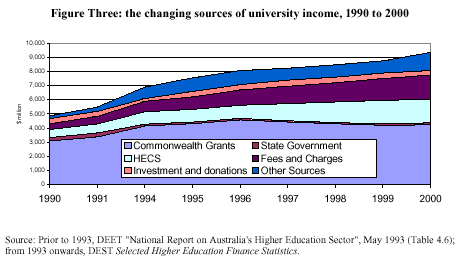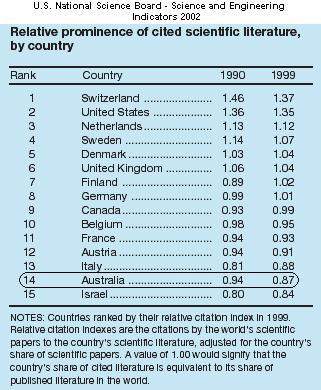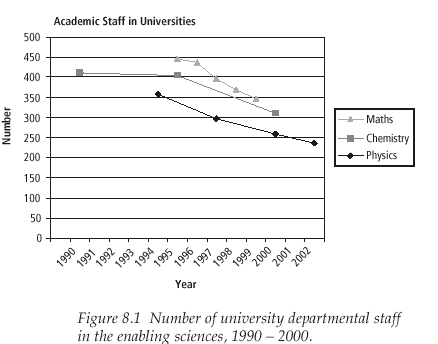Editorial-29
December 2002
|
A Graphic
Look Back... & Ahead
|
In 1974 the Australian State
Governments
effectively
ceded full financial responsibility for higher education in Australia
to the Commonwealth. However, all but national institutions operate under State
or Territory legislation, although the money comes from Canberra and the terms of
finance are decided by Canberra. Over a quarter of a century has past and it's
increasingly apparent that the consequences have been appalling. More than
any single event, it accounted for the de facto
repudiation of responsibility by the states
for one of their most precious assets, and any incentive for competition between
the states to foster and maintain the best simply died away. Furthermore, a direct
consequence of the Commonwealth's determination of budget allocations was the
nationwide Dawkinising of the Australian university
system by the Hawke Labor Government under the guise of providing universal higher education.
Territory legislation, although the money comes from Canberra and the terms of
finance are decided by Canberra. Over a quarter of a century has past and it's
increasingly apparent that the consequences have been appalling. More than
any single event, it accounted for the de facto
repudiation of responsibility by the states
for one of their most precious assets, and any incentive for competition between
the states to foster and maintain the best simply died away. Furthermore, a direct
consequence of the Commonwealth's determination of budget allocations was the
nationwide Dawkinising of the Australian university
system by the Hawke Labor Government under the guise of providing universal higher education.
The notably populist Coalition Government under John Howard has
exacerbated the demise of higher education and with it the relative standard of
Australian science, by reducing in absolute terms public support for universities
while required funding continued to increase. The states accuse the government of strangling the
universities while the Commonwealth accuses the universities of shoddy
governance and the states of inadequate oversight. And we have the
recent
ludicrous juxtaposition of the Minister for Education, Science and
Training, Brendan Nelson, putting out a media release with the headline, "INNOVATION
SCORECARD PUTS AUSTRALIA AMONGST THE BEST," according to
Backing Australia's Ability: Real Results Real Jobs, the Commonwealth
Government's Innovation Report for 2002-03. On the other hand the science weekly
Nature in its Editorial of December 12th writes, "Australia's
research community suffers not
 so
much from a tyranny of distance as one of scale. Australian science takes pride
in wringing high-quality research from scant resources. Despite increases in
government funding over the past two years, industrial support for research
remains scarce, and Australia's universities are cash-strapped. Now it risks
slipping further behind as the price of research rises."
so
much from a tyranny of distance as one of scale. Australian science takes pride
in wringing high-quality research from scant resources. Despite increases in
government funding over the past two years, industrial support for research
remains scarce, and Australia's universities are cash-strapped. Now it risks
slipping further behind as the price of research rises."
In addition TFW has
previously
shown graphs which indicate, and indicate strongly, that Australia is
slipping
further
behind when ranked with what we perceive are
the members of our
peer group. So for example
Australia's total R&D spending as a percent of GDP remains at 1.54%. The
Coalition Government makes
the point that Federal expenditure on R&D is 0.70% of GDP, as compared with
0.54% for the UK, and
0.59% for Canada and therefore it is the private sector
that's
dragging the chain. However, objective analyses as
to what are the causes for low private sector
investment, compared to the UK and Canada for
example, are lacking. So what's missing in our economic environment that's present
in theirs? Furthermore, it is unclear as to what part of Australia's 0.70% of
GDP contributed by the tax payer is going to fund applied research at the expense of basic studies and how
that compares with our cohort. For example, the Australian Research
Council (ARC), the only significant contributor to non-medical basic research,
earmarks a significant proportion of its budget allocation to its "Linkage
Program" (see its
2002 - 2004 Strategic Action Plan). According to the ARC, "The focus of the
linkage research supported by the ARC is promoting research partnerships with
business and industry and other publicly funded research agencies..." Professor
Vicki Sara, ARC CEO, has stated in testimony to the Senate estimates committee
overseeing the ARC that some 30% of ARC funding goes to linkage programs.
Speaking of Canada, it's worth
re-examining Canada's support for R&D past present and projected through 2010.
Comparing the time course to that of Australia's it's interesting to note that
the two nations were virtually identical in support for R&D in the mid 1990s
at which point we nose-dived and have never recovered.
which point we nose-dived and have never recovered.
Backing Australia's ability
halted the slide but hasn't reversed it. In the meantime Canada's
Chrétien
government has thumped the
table and set a target of 3% of GDP as support for R&D by 2010. Its
Minister for
Industry, Alan Rock,
remains adamant the he intends the target to be met. So far there is no
indication that our Minister for Education, Science and Training has any
intention of talking to him, or Lord Sainsbury, UK Parliamentary Under-Secretary
of State for Science and Innovation to seek their views of how their governments
are looking to realise their stated objectives -- just to point out two
individuals who
might be worth having a serious chat to. And of course there's the European
Community's stated commitment to attain a goal of 3% of GDP to support R&D
by decades end.
But She'll be right mate; the Minister is taking the "product"
of of his issues papers, 600 plus garnered submissions, and
the
Reference Group assessment for his Higher Education Review,
directly for processing during the May budget considerations.
The Group of Eight in publishing the graph below would appear to disagree
as to the well being of Australia's R&D sector,
and although the methods used to forecast future support for R&D through
2005/2006 haven't been revealed by the Go8 neither has Dr. Nelson publicly
questioned the forecast of 1.39% for Australia vs 2.45% for the OECD weighted
average by '05/'06.

Understandably the government wants to put the most flattering light on the
nation's achievements and this
 calls into question the objectivity of its conclusions. We are told repeatedly
that Australia "punches above its weight" when it comes to its international
standing in research. Just what this means is open to debate, but it's
interesting to look at what ought to be something approaching an unbiased
assessment of Australia's relative standing. The table to the left
published by the United States National Science Board, suggests that not to be
the case and shows a worrisome decline in our standing over the past decade.
Taking into account the fact that citation indices lag several years behind work
in progress, the table when assessed against the data summarised in the graphs above, allow at least the tentative conclusion that Australia is going to slip
further behind in the current decade. For example, while Prime Minister Howard
recently highlighted the importance of the enabling sciences (mathematics,
physics, chemistry), during the tenure of the Coalition government there has been
an alarming decline in their university staffing (FASTS policy statement Figure 8.1
below). And how thorough and how objective Dr. Nelson's designated assignment to
assess the nation's universities and research institutions abilities to do
research remains to be seen.
calls into question the objectivity of its conclusions. We are told repeatedly
that Australia "punches above its weight" when it comes to its international
standing in research. Just what this means is open to debate, but it's
interesting to look at what ought to be something approaching an unbiased
assessment of Australia's relative standing. The table to the left
published by the United States National Science Board, suggests that not to be
the case and shows a worrisome decline in our standing over the past decade.
Taking into account the fact that citation indices lag several years behind work
in progress, the table when assessed against the data summarised in the graphs above, allow at least the tentative conclusion that Australia is going to slip
further behind in the current decade. For example, while Prime Minister Howard
recently highlighted the importance of the enabling sciences (mathematics,
physics, chemistry), during the tenure of the Coalition government there has been
an alarming decline in their university staffing (FASTS policy statement Figure 8.1
below). And how thorough and how objective Dr. Nelson's designated assignment to
assess the nation's universities and research institutions abilities to do
research remains to be seen.
Perhaps the most serious concern is what appears to be authentic ignorance
and self delusion on the part of the Minister as to what constitutes an
outstanding national system of higher education.

Alex Reisner
The Funneled Web







